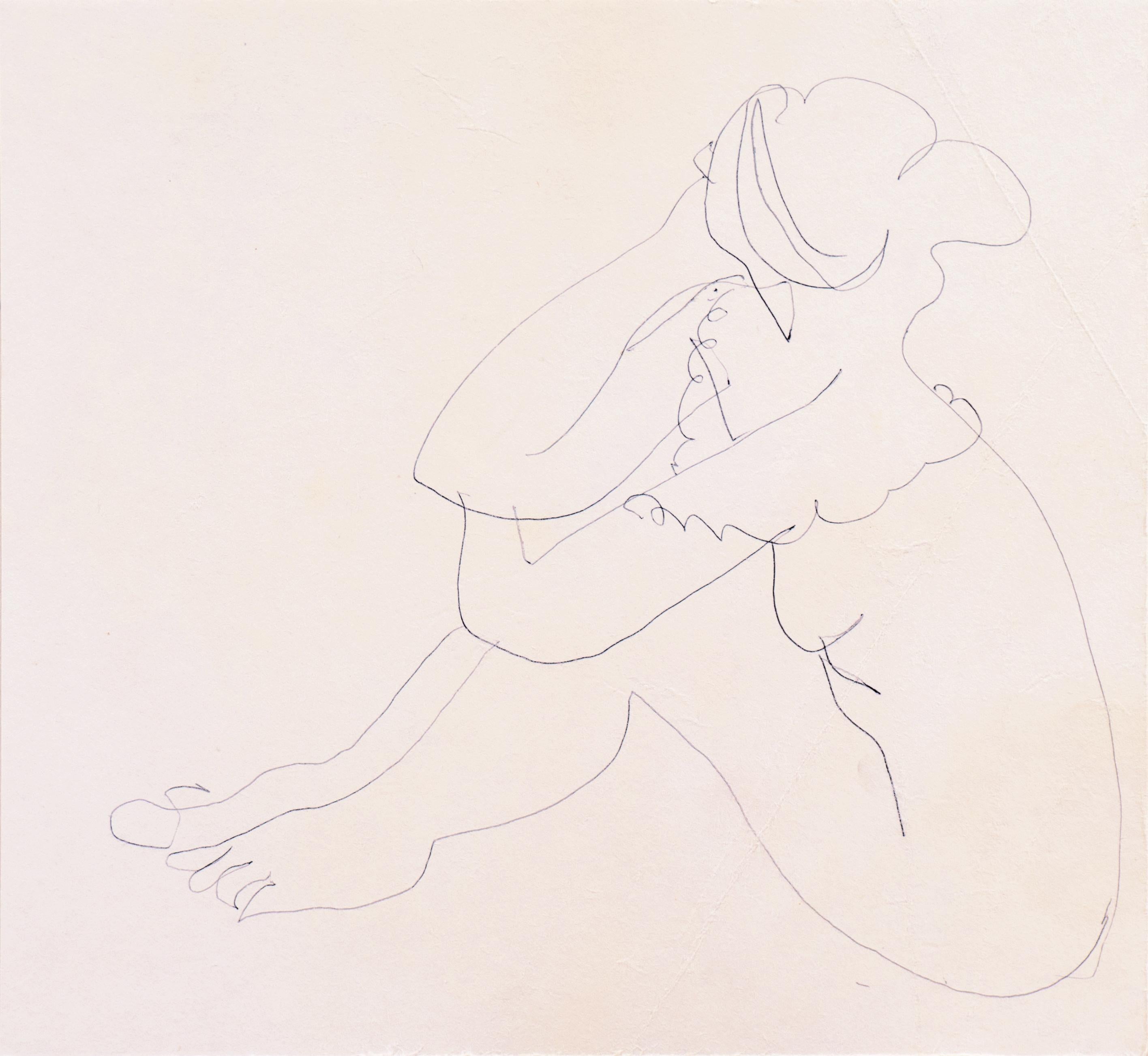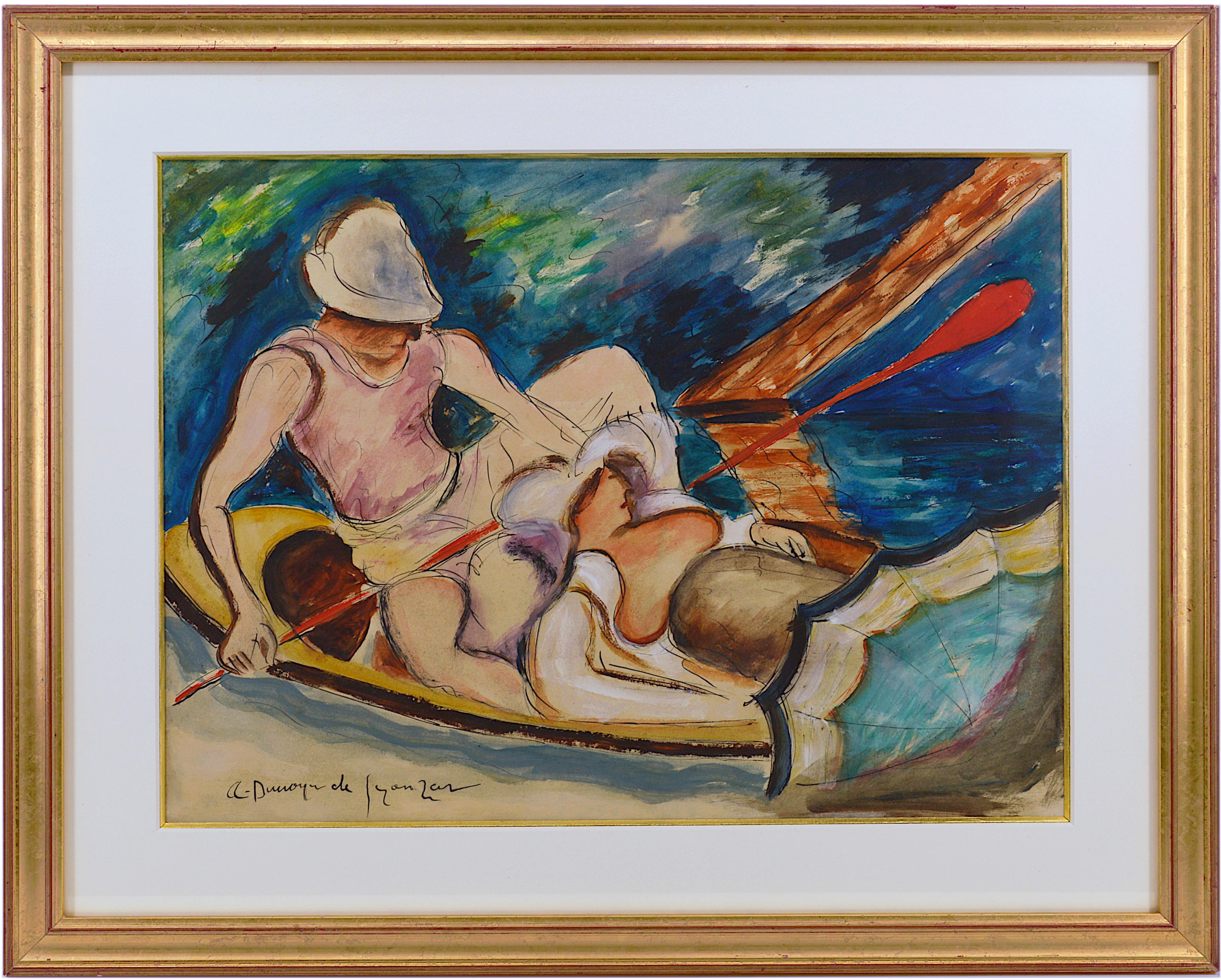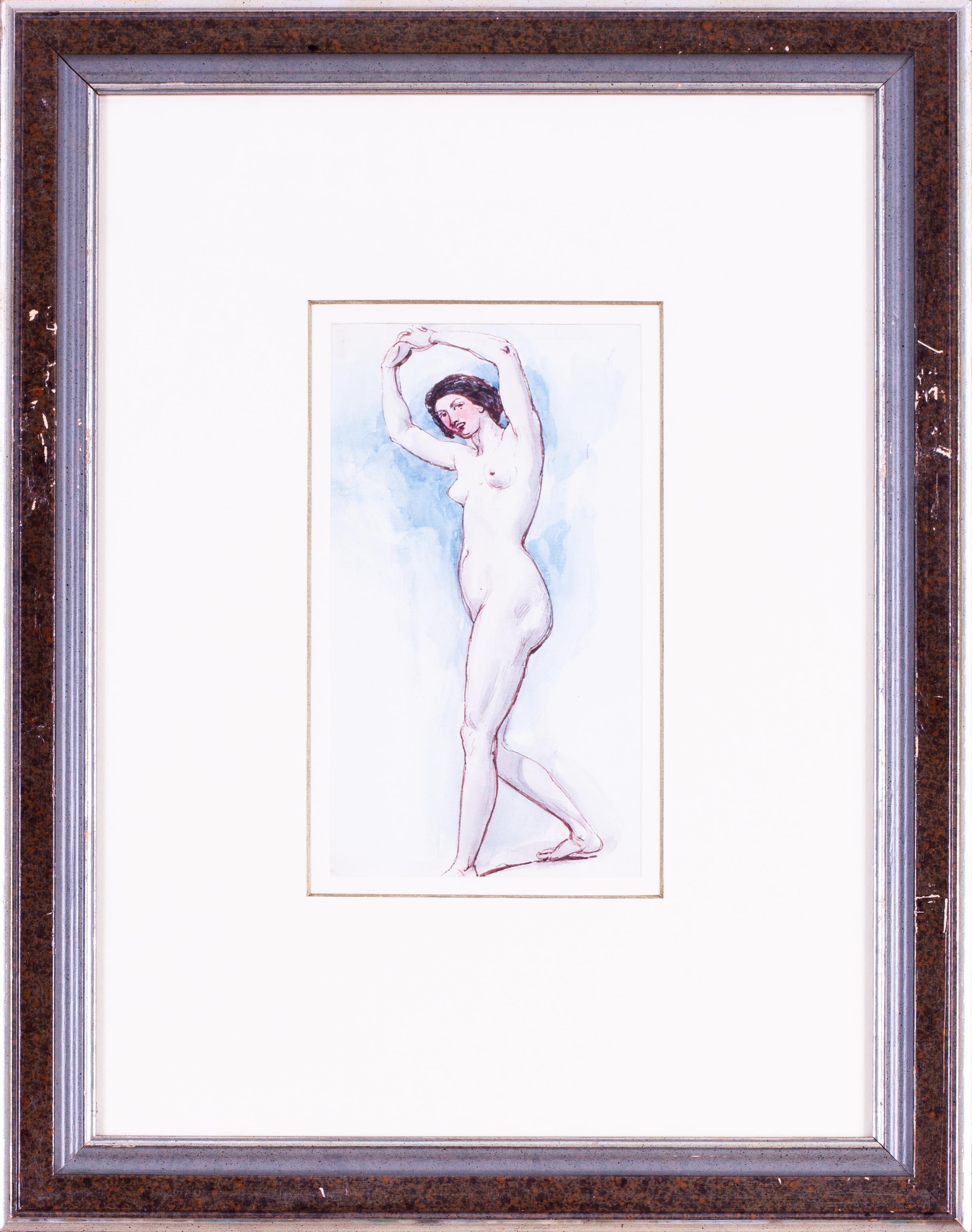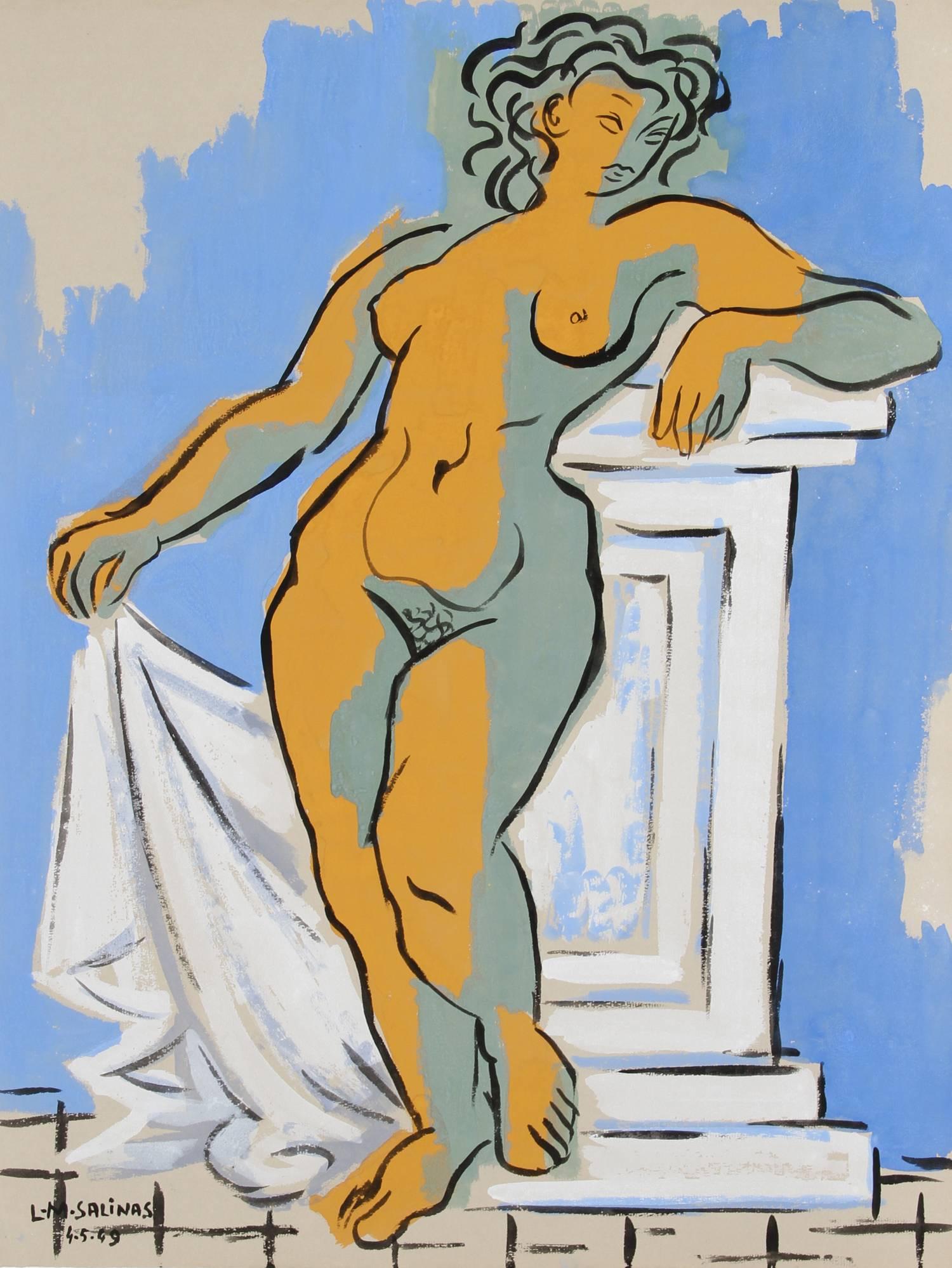Paul DelvauxStudy for “L’Acropole”1965
1965
About the Item
- Creator:Paul Delvaux (1897-1994, Belgian)
- Creation Year:1965
- Dimensions:Height: 27.75 in (70.49 cm)Width: 35.5 in (90.17 cm)Depth: 1.25 in (3.18 cm)
- Medium:
- Movement & Style:
- Period:
- Condition:
- Gallery Location:New Orleans, LA
- Reference Number:
Paul Delvaux
Paul Delvaux was born in 1897 in Belgium. He was one of the leading exponents of Surrealism, as well as one of the most popular painters of all time. He is famous for his female portraits located into mysterious surreal interiors and landscapes. In 1965, Delvaux was encouraged by Mira Jacob, a private collector of Symbolist and Surrealist paintings, to begin making lithographs. Later in 1976, Jacob published her book Paul Delvaux: Graphic Work, for which the Belgian artist produced many engravings, some of which are dry-points. Delvaux died in 1994.
- ShippingRetrieving quote...Ships From: New Orleans, LA
- Return PolicyThis item cannot be returned.
- Japanese Shunga, Sitting WomanLocated in New Orleans, LAA beautiful example of the Japanese art form known as shunga, this sensual work depicts woman exploring her sexuality. Hand-painted on paper with splashes of vivid gouache color, the...Category
Early 20th Century Other Art Style Nude Drawings and Watercolors
MaterialsPaper, Paint, Gouache
- La femme préhistorique (Prehistoric Woman)By James Jacques Joseph TissotLocated in New Orleans, LAJames Tissot was among the most successful and critically acclaimed artists of the Victorian era. Although the artist is celebrated for his elegant scenes of fashionable life in Paris and London, this work is a fascinating rarity within his oeuvre. In this monumental pastel, Tissot depicts a prehistoric woman draped in a tiger skin, presented with a striking pose and heroic air. His delicate portraiture, combined with his fascination with conveying texture, demonstrates why he was one of the most revered artists of his generation, and La femme préhistorique illustrates the remarkable technique for which he was renowned. This work was completed in preparation for a series of works exploring the Old Testament undertaken by Tissot from 1899-1902 that remained unfinished at the time of his death. A portion of this series focused on illustrations of Adam and Eve, and among these sketches were images of a nude Eve partially draped in animal furs. Towards the end of his life, following his conversion to Catholicism, biblical subjects became important to the artist. A few years before this work was completed, Tissot embarked upon a highly ambitious group of nearly 300 watercolors illustrating the New Testament, presenting the illustrated epic in its entirety at the Paris Salon of 1894. Both of these series were a critical artistic departure for the artist, stemming from a desire to create works separated from his typical images of modern society. This pastel imagines Eve as the prototype of womanhood in the guise of a prehistoric woman. Tissot rarely painted the nude, and his skill as a draftsman highlights the figure's natural beauty, contrasting it with the stark landscape surrounding her. Although a study, this monumental work is incredibly well-finished and highly engaging, with the statuesque model commanding the majority of the canvas. Her pose is strong and theatrical, and she addresses the viewer with a direct, confident gaze. The imagined historical subject of this drawing is grounded by Tissot’s exceptional attention to detail. A master of conjuring an array of textures, Tissot showcased this ability in this work by juxtaposing many types of fabrics and natural elements within one composition. The tiger skin with which the woman partially covers herself was a favorite studio prop of Tissot’s, appearing in many of his most influential works from the period, including several paintings of his partner and favorite model Kathleen Newton. It, in particular, showcases the artist’s understanding of texture, yet it also serves as an exotic element that elevates the sensuality of the scene when placed against the woman’s bare skin. Born in 1836 in the port town of Nantes, Tissot traveled to Paris at the age of 20 in order to join the studios of Hippolyte Flandrin and Louis Lamothe. During this period, he became close with James Abbott McNeill Whistler, Edgar Degas and Edouard Manet, and the impact of these friendships is reflected in his portraits of modern life. Having enjoyed considerable success in Paris during the 1860s, Tissot fought in the Siege of Paris, and after the fall of the Commune in 1871, he went to London, where he stayed for the next ten years. He was met with incredible success there, and he also met the love of his life, Kathleen Newton, a divorcée, with whom he lived from about 1876 until her death in 1882. Today he is regarded among the great masters of Belle Époque painting, and his works can be found in important collections worldwide, including the Metropolitan Museum of Art, the Brooklyn Museum, the National Gallery of Art, the Musée d’Orsay, the Tate Gallery and many others. This pastel remained in Tissot's private collection until his death in 1902 and is referenced in the posthumous 1902-3 valuation of Tissot's home at 64 avenue du Bois...Category
Early 20th Century Academic Nude Drawings and Watercolors
MaterialsLaid Paper, Canvas, Oil Pastel, Pastel
- Homme à l'agneau, mangeur de pastèque et flûtisteBy Pablo PicassoLocated in New Orleans, LASigned, dated and numbered “Picasso / 3.2.67 / II” (upper right) Crayon on paper Hailed among the fathers of modern art, Pablo Picasso possessed a seemingly e...Category
20th Century Modern Nude Drawings and Watercolors
MaterialsCrayon, Paper
- Portrait of a Mother and Child by Tsuguharu FoujitaBy Léonard Tsuguharu FoujitaLocated in New Orleans, LATsuguharu Foujita 1886-1968 | Japanese-French Portrait of a Mother and Child Signed “Foujita / Paris” (lower left) Ink and watercolor on paper An artistic luminary well ahead of his time, Tsuguharu Foujita burst onto the international art scene in the early 20th century as one of the most important artists in early Japanese modernism...Category
20th Century Post-Impressionist Portrait Drawings and Watercolors
MaterialsPaper, Ink, Watercolor
- Musiciens Sur Fond Multicolore By Marc ChagallBy Marc ChagallLocated in New Orleans, LAMarc Chagall 1887-1985 Russian Musiciens sur fond multicolore (Musicians on a multicolored background) Signed 'Chag' (on the sleeve of the right figure); stamped with the signature 'Marc Chagall' (lower right) Tempera, gouache, colored ink and India ink and pastel on paper “The fact that I made use of cows, milkmaids, roosters and provincial Russian architecture as my source forms is because they are part of the environment from which I spring and which undoubtedly left the deepest impression on my visual memory of the experiences I have." - Marc Chagall Marc Chagall’s 1981...Category
20th Century Post-Impressionist Figurative Drawings and Watercolors
MaterialsPaper, Pastel, Ink, India Ink, Tempera, Gouache
- Mer De Sable By Alexander CalderBy Alexander CalderLocated in New Orleans, LAAlexander Calder 1898 – 1976 American Mer de sable (Sea of sand) Gouache and ink on paper Signed and dated with artist’s monogram “CA and ‘75” (lower right) This vibrant gouache ...Category
20th Century Post-Impressionist Abstract Drawings and Watercolors
MaterialsPaper, Ink, Gouache
- 'Seated Nude' Paris, Louvre, Salon d'Automne, Académie Chaumière, LACMA, SFAABy Victor Di GesuLocated in Santa Cruz, CAStamped, verso, with estate stamp for Victor Di Gesu (American, 1914-1988) and created circa 1950. A graphite drawing of a young woman, shown nude and seated with her chin cupped in...Category
1950s Post-Impressionist Nude Drawings and Watercolors
MaterialsPaper, Ballpoint Pen
- "Boating on the Morin River"By André Dunoyer de SegonzacLocated in Saint Amans des cots, FRPen, ink, watercolor and wash on paper by André Dunoyer de Segonzac, France, 1922-1924. Boating on the Morin River. Measurements : with frame: 52.5x65x2 cm - 20.7x25.6x0.8 inches / without frame: 36.5x45 cm - 14.4x17.7 inches. Signed lower left "A. Dunoyer de Segonzac". Colors may vary slightly depending on your screen. The lighter band at the top and the bottom of the piece, visible in the first picture, is only due to the reflection in the protective glass. It does not exist. In its frame gilt with gold leaf and its protective glass. André Dunoyer de Segonzac was born in Boussy-Saint-Antoine (Essonne) July 7, 1884. After his schooling at high school Henri IV, as early as 1900, he attends classes at the National School of Fine Arts in Paris in free listener where he will befriend Charles Dufresne. In 1903, he enters the private studio of Luc-Olivier Merson. In 1907, he studies with Jean-Paul Laurens and attends the La Palette and Colarossi academies in Montparnasse. He meets Luc-Albert Moreau and Jean-Louis Boussingault with whom he shares a studio. His first drawings are published in 1908 in The Great Review and The Witness. Nearly indifferent to contemporary aesthetic revolutions, Dunoyer de Segonzac undertakes, with Jean-Louis Boussingault and Luc-Albert Moreau, to revive Gustave Courbet's realism by performing still lifes, nudes, landscapes, in a thick paste and masonry . In one of his letters to the painter Maurice Boitel, he wrote in the 1950s: "I have not forgotten the heroic period of the independents - when we were grouped around Paul Signac, the charming and valiant Maximilien Luce - in these barracks where the living and authentic Art was grouped outside the academic formulas - or literary and systematic tendencies - which were to lead to this abstract aesthetic of which the painting dies. " In 1908, he begins exhibiting at the Salon d'Automne and the Salon des Indépendants, with Paul Signac and Maximilien Luce. He befriends Apollinaire, Max Jacob, Raoul Dufy and Vlaminck. From this period, renting a house belonging to Signac, Dunoyer discovers the landscapes of Saint-Tropez, to which he will remain faithful and where he lived until the end of his life. He stays in Saint-Tropez only in the summer season. For the rest, he leads a real nomadic life, in search of the motive especially through the Île-de-France, the Grand Morin valley, Feucherolles, Chennevières-sur-Marne, Guyancourt, etc. "I also worked a lot on the banks of the Seine in Chatou, Bougival, Andrésy, Poissy and Triel that I particularly like, with its beautiful Gothic church that is reflected in the Seine and the high wooded hills that surround him", he will say. In 1910, he knows fashion designer Paul Poiret and meets Max Jacob, Raoul Dufy and Vlaminck. From 1910 to 1914, he travels to Italy, Spain, North Africa, and is interested in sport and dance (drawings of Isadora Duncan's Russian Ballets, 1911, The Boxers1910). From 1914 to 1918, mobilized in the infantry, he makes the war hardly, before being assigned to camouflage. He performs many war drawings, valuable for their artistic and documentary value. From 1919, he appears again in many exhibitions, including major Parisian salons. Nearly indifferent to contemporary aesthetic revolutions, Dunoyer de Segonzac undertakes, with Boussingault and Moreau, to revive Courbet's realism by performing still lifes, nudes, landscapes, in a thick and masonry paste. Enlisted in engraving by Jean Émile Laboureur, he makes nearly 1,600 brass plaques from 1919 to 1970. He was president of the Society of French painters-engravers. In 1921, he meets Paul Valéry, Léon-Paul Fargue and Jean Cocteau. In 1928, he makes a trip to America where he met with great success. In 1930, he becomes friend with Derain. In 1933 he receiveds the Carnegie Foundation of Pittsburgh Award and in 1934 the Venice Biennale. During the Occupation, in November 1941, he takes part in a "study trip" to Germany, organized by Arno Breker, accepting, like other artists of the most renowned, to visit the hotspots of German culture as well as artist workshops. After the war, he is exhibited in the best galleries...Category
1920s Realist Figurative Drawings and Watercolors
MaterialsPaper, Ink, Watercolor, Pen
- 19th Century British pen, watercolour drawing of a nude by William Edward FrostBy William Edward FrostLocated in Petworth, West SussexWilliam Edward Frost RA (British, 1811 – 1877) Female nude Pen and ink and watercolour 7.1/4 x 4 in. (18.2 x 10 cm.) Provenance: The Maas Gallery, London. No. 13863Category
19th Century Academic Nude Drawings and Watercolors
MaterialsInk, Watercolor, Paper, Pen
- "Nude Study no. 47", Gouache on Paper, 1949By Laurent Marcel SalinasLocated in Long Island City, NYArtist: Laurent Marcel Salinas, French (1913 - 2010) Title: Nude Study no. 47 Year: 1949 Medium: Gouache on Paper, signed and dated l.l. Size: 24 x 19 inchesCategory
1940s Fauvist Nude Drawings and Watercolors
MaterialsGouache, Paper
- "Nude Study no. 30, " Gouache on Paper, 1949By Laurent Marcel SalinasLocated in Long Island City, NYArtist: Laurent Marcel Salinas, French (1913 - 2010) Title: Nude 30 Year: 1949 Medium: Gouache on Paper, signed u.r. Size: 19 in. x 24 in. (48.26 cm x 60.96 cm)Category
1940s Fauvist Nude Drawings and Watercolors
MaterialsGouache, Paper
- Nude Study no. 50, Gouache on Paper, 1949By Laurent Marcel SalinasLocated in Long Island City, NYArtist: Laurent Marcel Salinas, French (1913 - 2010) Title: Nude Study no. 47 Year: 1949 Medium: Gouache on Paper, signed and dated l.l. Size: 24 x 19 inchesCategory
1940s Fauvist Nude Drawings and Watercolors
MaterialsGouache, Paper
Recently Viewed
View AllRead More
Wear Louis Comfort Tiffany’s Genius on Your Finger with This Vivid Ring
In his jewelry making, the designer rarely used diamonds — this rare example has two.
You Won’t Find a More Handsome Stopwatch Than This 1890s Pocket Chronograph
A Grand Complication from the golden era of pocket watches, the Marius Lecoultre pocket watch does everything but uncork your wine.






